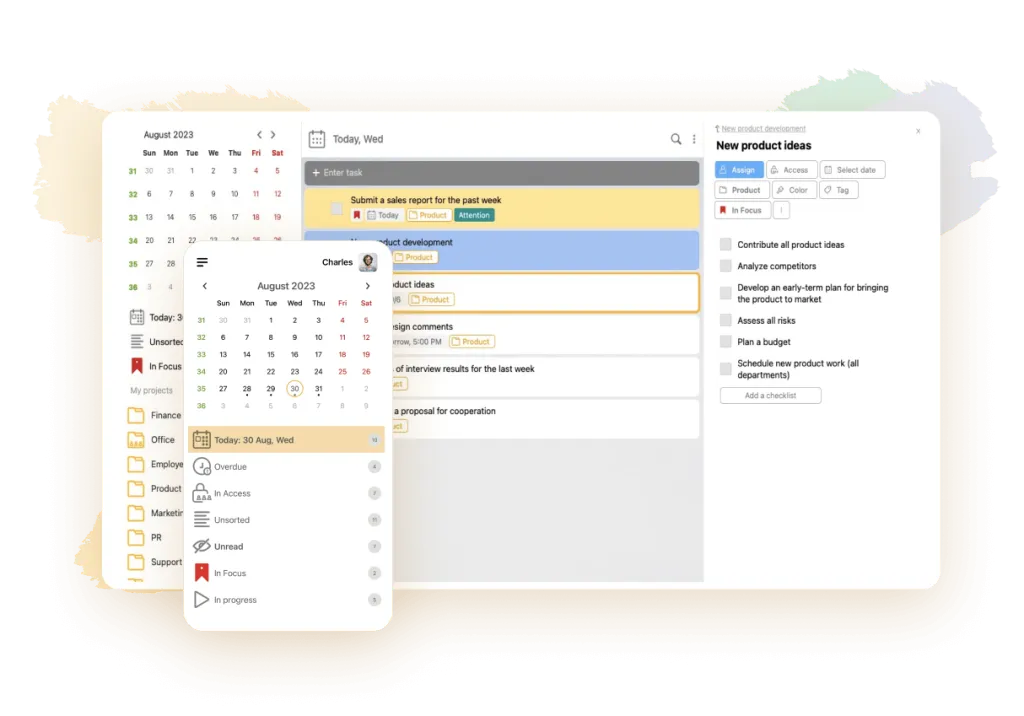
Ted Scott
March 4, 2024
A manager must be able not only to set goals, inspire employees, but also to manage his own and team working time. The concept, definition of stages, essence, types, rules and methods of effective time management will be revealed in today’s article.
Time management and its importance for effective leadership
Competent management is the main key to the success of any company striving for prosperity and development. And the characteristic feature of every good manager is the ability to use working time rationally, to keep up with everything, and to fulfill managerial duties in a timely manner.
At the same time, a modern manager, although making important decisions for the company, is also obliged to monitor and manage not only his personal working time, but also the time of his subordinates and the entire company as a whole. This task can be performed either independently or with the help of a secretary.
The main task of planning the manager’s working day
The key function of time management is to eliminate the deficit of time, to solve the problem with its constant lack of time to solve the planned tasks. Effective planning eliminates the need to overwork, rush, and fuss, leaving energy for something really important.
In addition, built discipline and organization in the office solves the issue of lack of a plan, a large accumulation of unfinished business, increase motivation in the team, get rid of the syndrome of constant fatigue and permanently close the unpleasant problem with the completion of work at home.
Myths about time management
The basic essence of the skill was formulated back in ancient Rome, almost two thousand years ago. After all, time management has been of interest to people since antiquity. In particular, this issue was dealt with in detail by Seneca, a philosopher, poet and statesman. It is not surprising that since then the sphere has been covered with a lot of myths and misconceptions, like any other topic related to self-improvement and increasing personal efficiency.
Let’s analyze these beliefs in order to understand what in this area is worth believing, and what on the contrary a manager should not consider seriously.
Myth 1. Time is beyond man’s control
Part of the statement is true, because humans are indeed unable to turn back time, change its speed, or adjust its other laws.
However, any person has the opportunity to learn how to manage their own actions, competently organize activities without costs. And this allows everyone to control personal and professional life, to have available labor hours as efficiently as possible, to do more useful work in less time.
Myth 2: Effective work is always intensive labor
The root of the misconception lies in the fact that most people do not understand the essence of time management. Heavy workload, lack of rest, hard and continuous labor often leads to overwork, apathy and even depression. And in such a state it is impossible to increase personal productivity and achieve major goals.
Time management implies not increasing the amount of work undertaken, but concentrating most of the time on useful tasks, necessary actions. In addition, effective management helps to avoid “chronophages” - time eaters.
Myth 3. Planning deprives a person of freedom
Many people try not to get involved with time management because they are convinced that time management constrains, turns a living person into a robot who exists strictly according to a rational schedule. However, this is not the case.
Competent and rational allocation of working time implies not only completing projects, but also leaving time for rest. Time management helps to easily accomplish a large number of work and personal tasks without stress, stress and procrastination, and then spend time with loved ones or doing sports and creative activities.

Rules and principles of working time planning
There are several general recommendations for planning a successful working day, which will allow not only the boss, but also a person in any other position to be several times more effective throughout the working day. Let’s consider them in a little more detail.
Rule 1. Rise at the same time
Maintaining a disciplined mind and body throughout the day is only possible by observing the initial stage of any planning. Namely, getting up in the morning at the same hour. Additional bonuses of getting up in the morning are a rested body and a burst of energy.
Rule 2. A positive attitude at the beginning of the day
Morning mood has a big impact on achieving goals throughout the day. Keeping a gratitude journal, self-motivation minutes, reading affirmations, etc. - are great early morning habits to do right after rising.
Rule 3. Correct start of the day
A harmonious day is impossible without a favorable morning, the tone of which is set by a well-slept and rested body, charged with energy and vigor. Therefore, in no case sacrifice a good night’s sleep, a healthy breakfast for the sake of immediate desires in the evening and at night. Time management tells you to prioritize properly.
Rule 4. Consideration of different factors when planning workdays
Each person has certain periods of activity depending on their own biorhythms. You should find out when your personal productivity peaks by observing yourself for a few days or weeks. After that, when planning your day, you should place the most important tasks in productive daily intervals, while periods of decline are better left for rest, breaks, lunches, etc.
Rule 5. Mandatory breaks during the day
A short rest during the working day is necessary for any person, as it allows the body to recover and regain concentration for work. The duration and frequency of breaks are set by each individual on a personal basis. However, it is desirable to find in each hour at least a couple of minutes for rest. You can use them to put your desk in order, wash your mug, water your flowers, take a walk in the fresh air, etc.
Rule 6. Bringing things to a conclusion
Constantly jumping from one thing to another, distracted by small and unimportant activities (calls, answering messages, talking to colleagues) leads to time theft. Try to bring each process to its logical conclusion before you start another.
Rule 7. Making good use of free time
Uninformative meetings, idle time in queues and traffic jams, airplane rides mercilessly kill time. Such periods can be filled with useful activities, such as listening to educational courses or audiobooks, and creating a schedule for the next day.
Rule 8. Adherence to the “70 by 30” principle
A typical mistake of beginners learning time management is to plan the whole time, while it is worthwhile to write down in the diary only about 70% of cases, leaving a few hours for force majeure and other circumstances. In addition, the remaining 30% of free time will save a person from the unpleasant feeling of being a robot, the feeling of being imprisoned in rigid frameworks, will save the nervous system from overwork and overload.
Also, when creating an individual schedule, it is very important to be realistic about your own capabilities, not to overwhelm yourself with a huge number of tasks. It’s better to guarantee that you have time for a small number of important things than to feel like a horse in the soap.
Rule 9. Preparing the to-do list in advance
Evening to-do schedule for tomorrow is an opportunity not to miss anything in the morning and afternoon hours of the next day. In this case, it is necessary not only to write down the actual tasks, but also to set the degree of importance for them, to distribute them into columns, so that first of all attention is paid to global, not minor tasks.
Rule 10. Putting everything back where it belongs
Searching for missing items inevitably wastes many times more time than putting everything back in its place immediately after use. Organizing your workplace also saves precious minutes during the day: it is therefore better to prepare a special organizer for pens, a folder for papers, a drawer for documents or receipts, etc. beforehand.
Rule 11. Leading a healthy lifestyle
Good health, positive attitude, positive energy strongly influence the high productivity of the manager, office worker and any other employee of the company. Therefore, it is recommended that every person should regularly engage in sports: fitness, swimming, yoga, running.
Rule 12. Satisfaction with one’s activities
Love for one’s own activity is the best way of motivation and self-organization for any specialist. Satisfaction with one’s own work allows planning and carrying out professional activities without feeling stressed and feeling dissatisfied.

Time planning methods
Most people are familiar with various time management methods. However, we will consider the most effective and productive of them, which are suitable for every manager during professional activities, regardless of the size of the company he manages, the technology used and the number of subordinates.
The “Alps” method
An effective technique that breaks down a large task into smaller ones, following the principle of climbing a mountain step-by-step. It includes five stages of planning:
-
Making a task list.
-
Estimating the length of time required to complete the tasks.
-
Allocating the right amount of time in the personal to-do schedule for each errand at a ratio of about 60% to 40%, where 40% is free time.
-
Create a step-by-step plan for accomplishing or delegating prioritized tasks with the duration of all steps.
-
Accounting for completed and uncompleted items in the plan.
The main problem with this method is that not every person has the ability to predict the exact deadline for a particular task. Therefore, it is not recommended to schedule all working hours. It is better to leave 40% of the schedule for unforeseen circumstances and unplanned actions.
Eisenhower matrix
A popular technique developed by one of the most productive and active U.S. presidents, Dwight Eisenhower. He proposed to draw up a scheme according to which all affairs should be scheduled in a table consisting of four groups:
-
Important and urgent tasks. Here you should specify the things that should never be postponed, since your future career directly depends on their precise fulfillment. For example, buying tickets for an important business trip, signing a contract with major customers or an urgent order.
-
Important and non-urgent tasks. These are tasks that you can take your time with, but your personal productivity and career advancement depend on them. For example, meeting new employees, checking repairs in the office, taking courses and trainings, attending events, learning foreign languages.
-
Unimportant and urgent tasks. Here, most often, we consider tasks that can and should be delegated and divided among subordinates or assistants to free up time to perform their own duties. For example, ordering stationery, sending invitation letters to partners, calling a master to fix the printer.
-
Unimportant and non-urgent tasks. These are tasks that are not useful for the company and professional activity. For example, personal conversations and meetings during work, browsing social networks.
Prioritizing with the help of a matrix allows you to pay attention to the most global things, not to be distracted by unnecessary things. Also, all tasks are written down in one place, will correspond to the conditions and order of fulfillment for each group of the matrix, so nothing is lost or forgotten.
Mistakes in executive time management
We have considered several useful techniques for time management of a manager, which you can apply and try in your team, above. However, it is also worth telling separately about the mistakes that can be encountered in time management. The main mistake of managers in the distribution of working time is that they try to exceed the plan and simultaneously solve several tasks at once. Often this tactic leads to the opposite result: fatigue, working hard, failure to meet deadlines for all projects, and force majeure.
Another example of a global time management blunder is not knowing how to use secretaries, not understanding how to delegate responsibilities, the habit of controlling everything, redoing things for employees, and giving out intrusive work advice. To avoid this it is necessary to learn to trust other people, give them more assignments, freeing up time for their own duties. Employees should not always obey the manager, so it is necessary to build trusting relationships to increase team communication and productivity.
Inadequate communication with subordinates is also a major mistake. To solve this problem, the LeaderTask program is an excellent solution, with corporate online chat, the ability to monitor and analyze the actions of each employee and department.
Example of a working day schedule
A manager can plan his day using a variety of methods. Here is a concrete example of a successful daily schedule made with the help of the Eisenhower matrix:
| Sector A. 08.00 - 08.30. Sales planner 08.50 - 09.00. Mail, answers to partners, clients 09.40 - 10.20. Purchase of tickets for business trip 16.00 - 17.00. Meeting with sponsors | Sector B. 10.30 - 11.20. Viewing the webinar from the training session 11.30 - 12.00. Getting acquainted with new office staff 12.20 - 12.40. Calling with business partners 13.30 - 14.30. Break, rest, lunch |
|---|---|
| Sector C. 13.00 - 13.30. Purchase of a new desk for the office 14.40 - 14.50. Viewing the new design on the website 14.50 - 15.00. Review comments on the website | Sector D. 1. Watch social media. 2. Watch news. 3. Watch YouTube. |
Completed to-do’s should be color-coded or crossed off the plate.
Also, if necessary, you can choose another technique or schedule your working day in a notebook-organizer, excel spreadsheet or use for this purpose the LeaderTask application, which has a convenient executive calendar with a schedule function.
LeaderTask is a time scheduling application

A modern service designed in the style of a business organizer for organizing meetings, tasks, project and employee management. Offers convenient tools for managers: goals, checklists, notifications and time reminders. Helps to quickly delegate tasks to subordinates.
Contains a convenient diary with a schedule for a day, week, month, year. Allows you to plan tasks of different levels in advance using the basis - a timeline. If necessary, it allows you to delete tasks, mark completed tasks with tags or color.
Offers training on how to use the program and maintain an executive calendar. It has online and offline modes. Synchronized on Windows, Mac, Android, iOS, Web-version platforms. There are free and paid tariffs, it is possible to get a test period of development.
Conclusion
The organization of the working day of the manager is a real art that is worth learning and acquiring more and more useful practical skills in this regard. For competent scheduling it is necessary to be able to use the rules and methods of time management, as well as special programs with an executive calendar.
However, such efforts will not go without a trace. They will help you cope with your responsibilities, make your work several times more efficient, and thus increase the efficiency of the whole team and improve the company’s daily performance.








